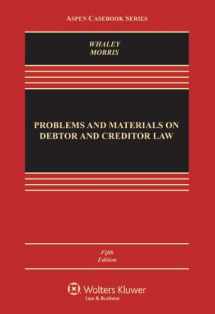
Problems and Materials on Debtor and Creditor Law, Fifth Edition (Aspen Casebook)
Book details
Summary
Description
Clear-cut and student-friendly, Problems and Materials on Debtor and Creditor Law offers an appropriate mix of problems, text, and cases to build a solid introduction to the Bankruptcy Code, statutory rules, and issues of bankruptcy law. The popular problems approach helps students focus on practical "nuts and bolts" of the law as it is applied in practice. Carefully chosen cases demonstrate how the bankruptcy system works and reflect recent developments in bankruptcy law. The text's sensible organization and manageable length allows instructors to tailor coverage to their own approach.
The Fifth Edition addresses the "means test" determining eligibility for basic bankruptcy relief in a new way, explaining that most attorneys rely on computer software to do the calculations. New cases and analysis support the discussion. Expanded treatment of Chapter 9 Bankruptcies coincides with the increasing number of cities going into bankruptcy. The discussion of involuntary bankruptcy has been significantly cut back. New Supreme Court cases have been added as well as some important lower court decisions--for example, the circuit courts--agreement that financing of "negative equity" on a traded-in vehicle as part of the purchase of a new car qualifies as a "purchase money security interest." A new segment on the treatment of "hostage value" collateral in consumer loans explores various possibilities under both the Bankruptcy Code and Article 9 of the Uniform Commercial Code, and looks at the difference between the "transformation" rule and the "dual status" rule.
Features:
- clear-cut and student-friendly--with an appropriate mix of problems, text, and cases
- solid introduction to the Bankruptcy Code, statutory rules, and issues of bankruptcy law
- popular problems approach&--focus on "nuts and bolts" of law as applied in practice
- carefully chosen cases demonstrate how bankruptcy system works
- up-to-date--reflects recent developments in bankruptcy law
- sensible organization--allows instructors to tailor coverage to their own approach
- manageable length--concise, efficient, and effective format
Thoroughly updated, the revised Fifth Edition presents:
- unique discussion of "means test" determining eligibility for basic bankruptcy relief
- explains that most attorneys rely on computer software to do the calculations
- new cases and analysis support the material
- expanded treatment of Chapter 9 Bankruptcies, as since cities filing bankruptcy grows more commonplace
- coverage of involuntary bankruptcy scaled back
- new Supreme Court cases
- important lower court decisions, e.g. financing of "negative equity" on a traded-in vehicle as part of the purchase of a new car qualifies as a "purchase money security interest"
- new segment on the treatment of "hostage value" collateral in consumer loans
- explores various possibilities under both the Bankruptcy Code and Article 9 of the Uniform Commercial Code
- looks at the difference between the "transformation" rule and the "dual status" rule


We would LOVE it if you could help us and other readers by reviewing the book
Book review



